***
Title: Archives 5. Journal of Architecture. Manuel Gallego
Author: Carlos Quintáns and Juan Rodríguez
Edited by: C2C Proyecto Editorial
2020. ISBN: 978-84-947678-7-6
Language: English and Spanish
332 pages
Manuel Gallego is an architect whose work is impossible to decipher if it is not interpreted from the territory that holds it. In other words, Manuel Gallego’s work defines, constructs and reveals the territory that contains it. His architecture might come first to define a posteriori, through the mechanisms developed by its author, the surrounding context. An architecture that physically and culturally constructs a territory.
Manuel Gallego es un arquitecto cuya obra es imposible descifrar si no se interpreta desde el territorio que la alberga. Dicho, mejor, de otro modo, la obra de Manuel Gallego define, construye y desvela el territorio que la contiene. Es, quizá, su arquitectura la que viene en primer lugar para definir a posteriori mediante los mecanismos desarrollados por su autor el contexto circundante. Una arquitectura que construye física y culturalmente un territorio.
An architect trained in Madrid under the guidance of Alejandro de la Sota, master of Spanish austere modernity, Manuel Gallego has developed all his work in the territory to which he himself belongs in: Galicia. Rarely is it possible to find such a singular and outstanding work with this exceptional capacity to crystallise the character and idiosyncrasy of a specific place. It would be a mistake, however, to limit ourselves to understanding Manuel Gallego’s work exclusively from his “Galician corporeality and character”. The inheritance of Galician popular architecture, the materiality and texture that define it, and the particular climatological and environmental conditions of Galicia are of course fundamental to interprete his architecture. However, the years of practice with Alejandro de la Sota were essential for Manuel Gallego to develop a unique language characterised by its elegant modernity and a special interest in detail and the material that composes it. This complex mixture of popular and vernacular roots, the understanding of the climate of a territory and modern abstraction resulted in an architecture rich in nuances and situations. An architecture which, despite its well-established foundations, will evolve over time, adapting conceptually and linguistically to the spirit of the times. Thus, his work will be enriched with certain formal issues of the postmodern era or, more recently, with the development of more complex fractioned geometries typical of contemporaneity. As Carlos Quintáns rightly points out at the beginning of this monograph, the main quality that will turn Manuel Gallego’s work into an essential practice is coherence, a virtue that in its mastery allows him to evolve his architectural approaches, his proposals, adapting them to the new needs of each moment without ever renouncing the basic foundations with which he began to work.
Arquitecto formado en Madrid bajo la guía de Alejandro de la Sota, maestro de la modernidad austera española, Manuel Gallego ha desarrollado toda su obra en el territorio al que él mismo pertenece: Galicia. En escasas ocasiones se puede encontrar una obra tan singular y sobresaliente con esa excepcional capacidad de cristalizar el carácter y la idiosincrasia de un lugar determinado. Sería un error, sin embargo, limitarnos a entender la obra de Manuel Gallego exclusivamente desde su “corporeidad y carácter gallego”. Son fundamentales desde luego para interpretar sus arquitecturas la herencia de la arquitectura popular gallega, la materialidad y textura que la definen, o las particulares condiciones climatológicas y ambientales de Galicia. Ahora bien, los años de práctica junto a Alejandro de la Sota serán esenciales para que Manuel Gallego desarrolle un lenguaje único caracterizado por su elegante modernidad y un especial interés por el detalle y la materia que lo compone. Esta compleja mezcla entre raíces populares y vernáculas, la comprensión del clima de un territorio y la abstracción moderna devienen en una arquitectura rica en matices y situaciones. Una arquitectura que, a pesar de contar con tan afianzados fundamentos, va a evolucionar a lo largo del tiempo adaptándose conceptual y lingüísticamente al espíritu temporal de cada momento. Así, su obra se enriquecerá con determinadas cuestiones formales de la época postmoderna o, más recientemente, con el desarrollo de geometrías fraccionadas más complejas propias de la contemporaneidad. Como bien apunta Carlos Quintáns desde el inicio de esta monografía, la cualidad principal que convertirá la obra de Manuel Gallego en una práctica imprescindible es la coherencia, virtud que en su dominio permite a su autor hacer evolucionar sus planteamientos arquitectónicos, sus propuestas, adaptándolas a las nuevas necesidades de cada momento sin renunciar nunca a los fundamentos básicos con los que empezó a trabajar.
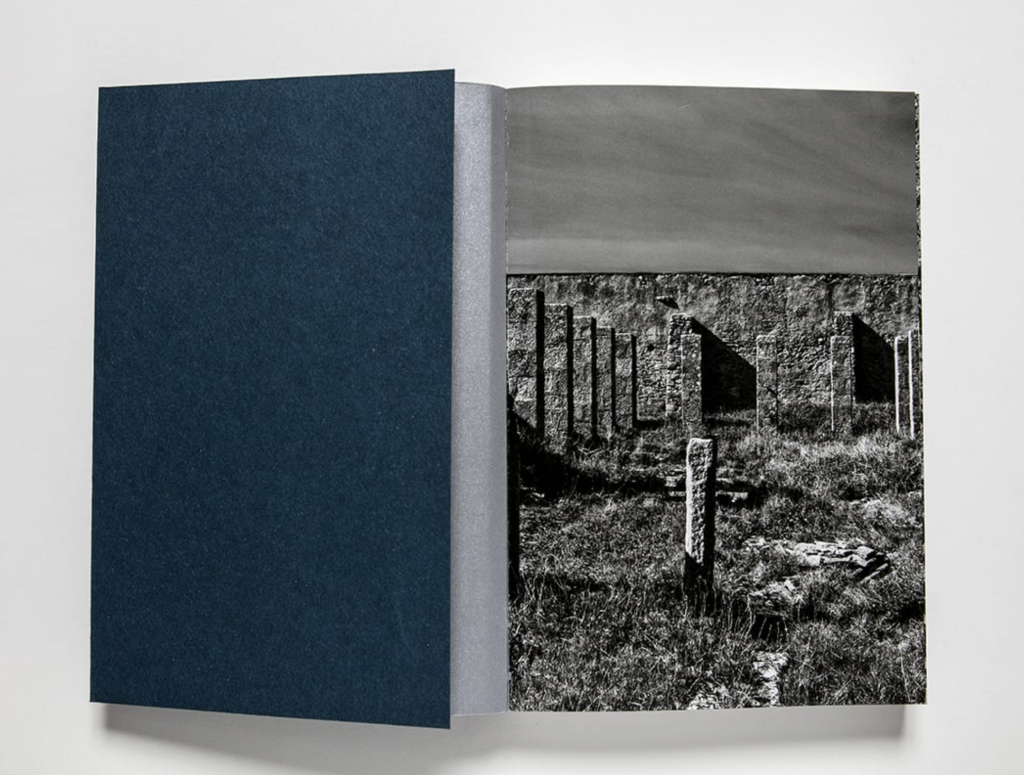
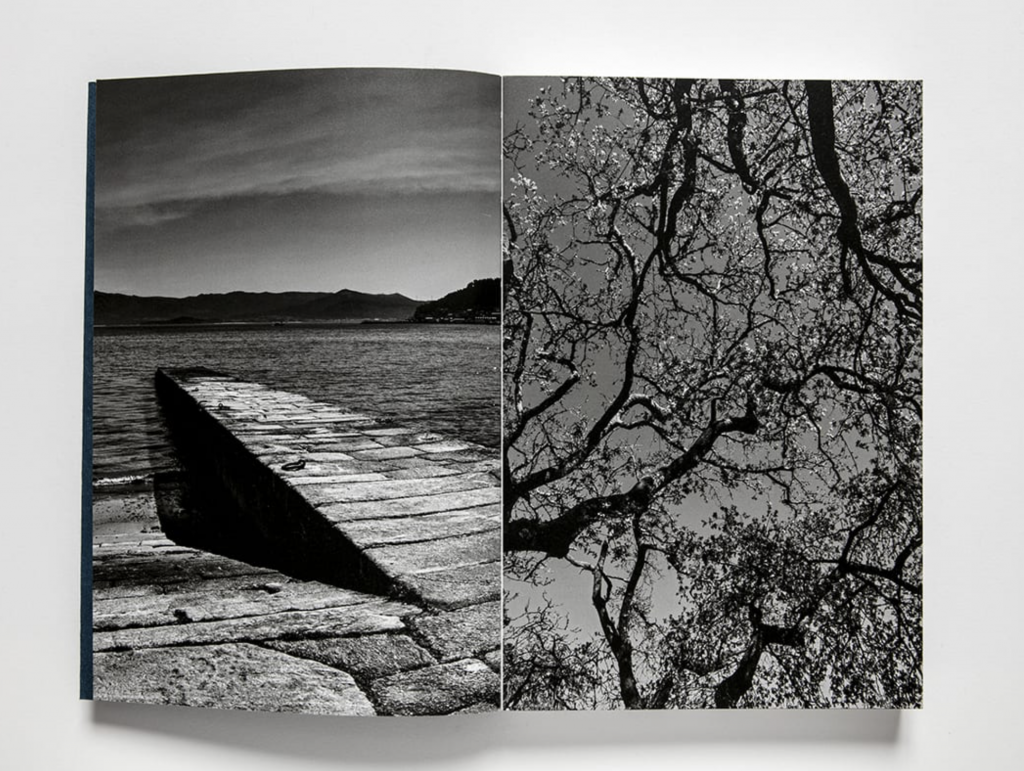
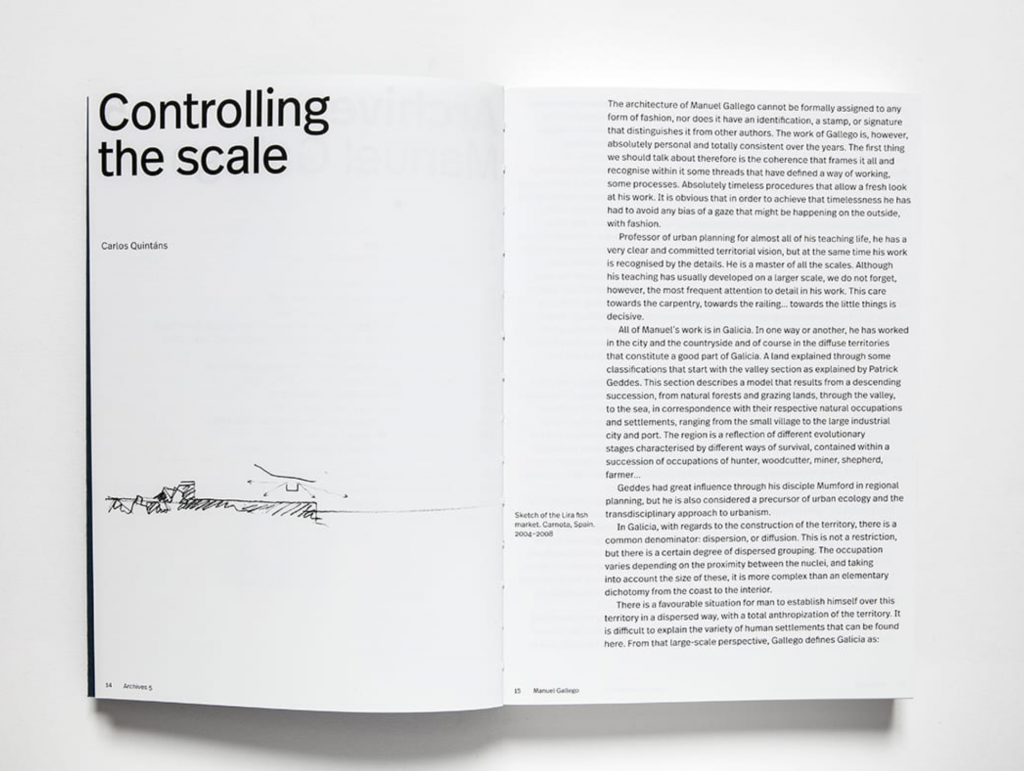
The present monograph, volume number 5 of Archives publication, presents a total of 13 built projects, all of them located in Galicia. It is necessary to clarify a special feature of this issue which is an exception in Archives to date. The projects are divided into two different blocks. Eight of them have current photographs, either because they are of more recent construction or because they have remained in a good state of conversation and faithful to the original project over the decades. The rest of the projects, five in total, are depicted only with original photographs from the time they were built, because their state of conversation is not desirable and it is not possible to show the original values of the project today. The need to establish a culture of respect for the natural and built environment, and to ensure its maintenance, is visibly demonstrated by this editorial decision.
La presente monografía, el volumen número 5 de la publicación Archives, nos presenta un total de 13 proyectos construidos, todos ellos situados en Galicia. Es necesario aclarar una particularidad especial de este número que es excepción en Archives hasta la fecha. Los proyectos se van a dividir en dos bloques diferentes. Ocho de ellos cuentan con fotografías actuales, ya sea por ser de más reciente ejecución o por haberse mantenido en buen estado de conversación y fieles al proyecto original a lo largo de las décadas. El resto de proyectos, cinco en total, aparecen representados tan sólo con fotografías originales de la época en que se construyeron, debido a que su estado de conversación no es el deseable y no es posible mostrar en la actualidad los valores originales del proyecto. La necesidad de establecer una cultura de respeto por el entorno natural y construido, y de garantizar su mantenimiento queda visiblemente patente con esta decisión editorial.
On opening the book we find, as usual, a series of photographs by the editor and photographer Juan Rodríguez. On this occasion, he focuses on the textures that define the materiality of the territory of Galicia and helps us to mentally construct a strong idea of environmental unity. It is clear from the outset the value that the physical and cultural context assumes in Manuel Gallego’s work. The extensive articles, written by Carlos Quintáns and Miguel Ángel Baldellou, build the critical and analytical scaffolding to approach Manuel Gallego’s work with guarantees, emphasising the special link between architect, work and context.
Al abrir el libro nos encontramos, como viene siendo habitual, con una serie de fotografías del editor y fotógrafo Juan Rodríguez. En esta ocasión, se fija la mirada en las texturas que definen la materialidad del territorio de Galicia y nos ayuda a construir mentalmente una fuerte idea de unidad ambiental. Queda claro desde el principio el valor que asume el contexto físico y cultural dentro de la obra de Manuel Gallego. Los artículos extensos, escritos por Carlos Quintáns y Miguel Ángel Baldellou, construyen el andamiaje crítico y analítico para aproximarse con garantías a la obra de Manuel Gallego, haciendo hincapié en la especial vinculación entre arquitecto, obra y contexto.
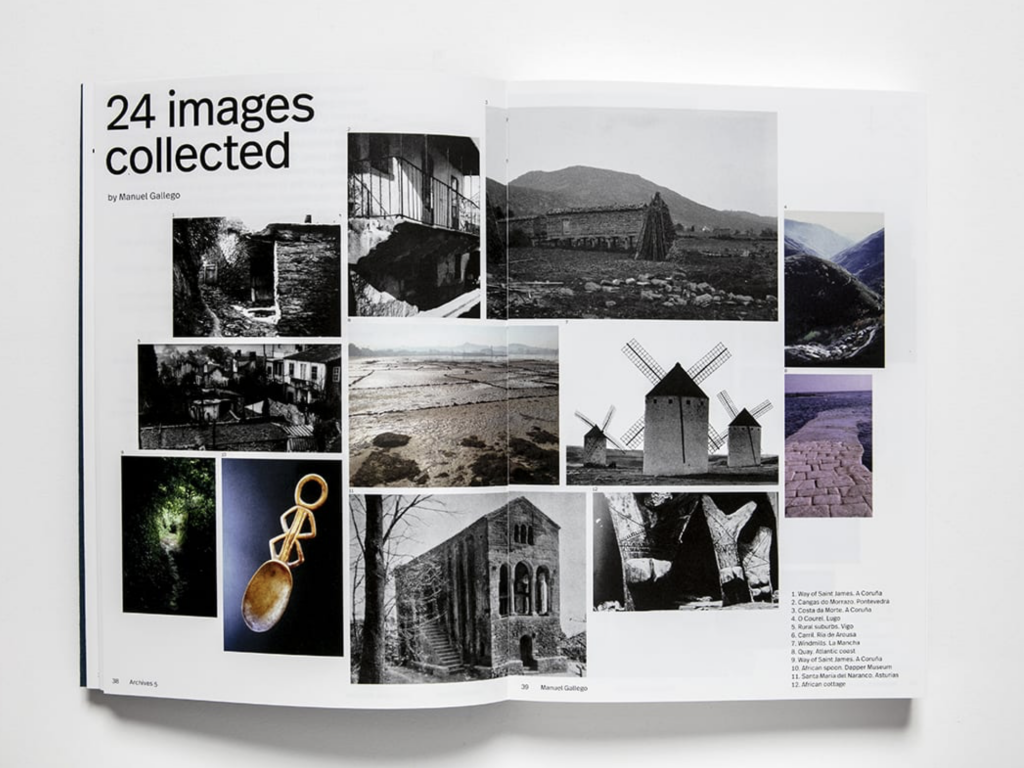
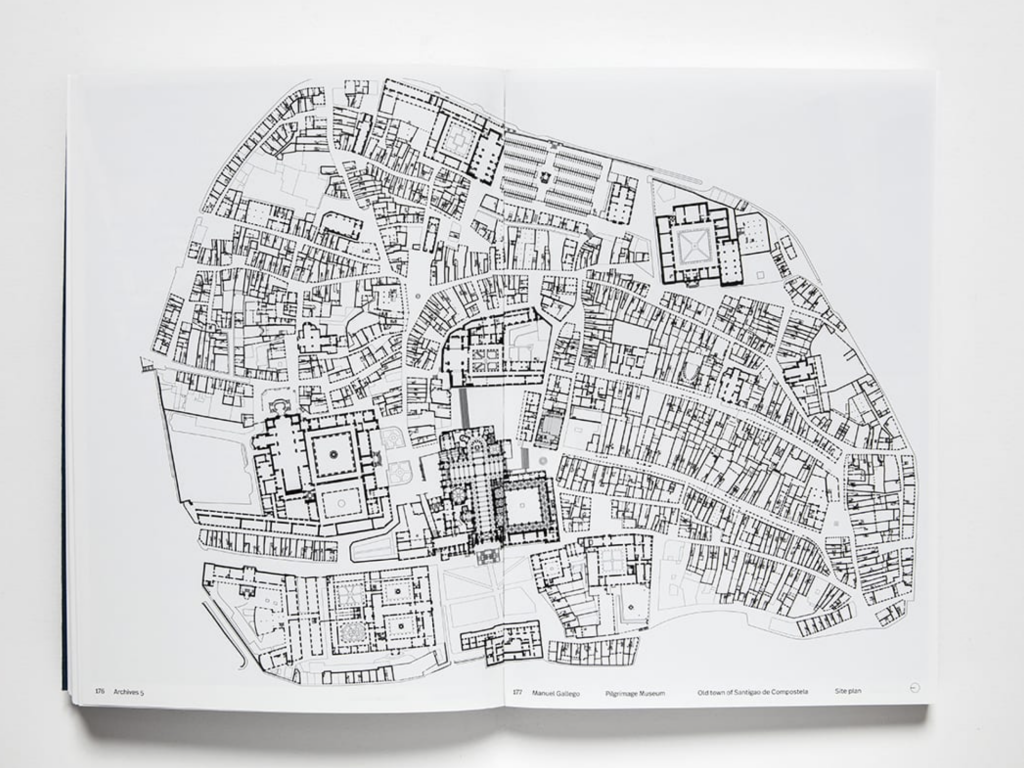
As if all these tools were not enough, the monograph is completed with an article by Manuel Gallego himself on the artist Enrique Ortiz Alonso. This transversality between disciplines and approaches has been strongly established in the Archives monographs. The effort to bring together divergent approaches to the act of creating deserves special mention. The ability to offer multiple possibilities for interpreting reality and, more importantly, for constructing a particular gaze, seems to us to be the fundamental virtue of the Archives monographs, an ambition that is exceptionally fulfilled in this issue on Manuel Gallego.
Por si todas estas herramientas no fueran suficientes, la monografía se completa con un artículo del propio Manuel Gallego sobre el artista Enrique Ortiz Alonso. Esta transversalidad entre disciplinas y enfoques se ha establecido con fuerza en las monografías de Archives. El esfuerzo por aglutinar acercamientos divergentes sobre el acto de crear merece ser especialmente reseñado. La capacidad de ofrecer múltiples posibilidades para interpretar la realidad y, lo que nos parece más importante, para construir una mirada determinada, nos parece la virtud fundamental de las monografías de Archives, ambición que queda excepcionalmente cumplida en este número sobre Manuel Gallego.
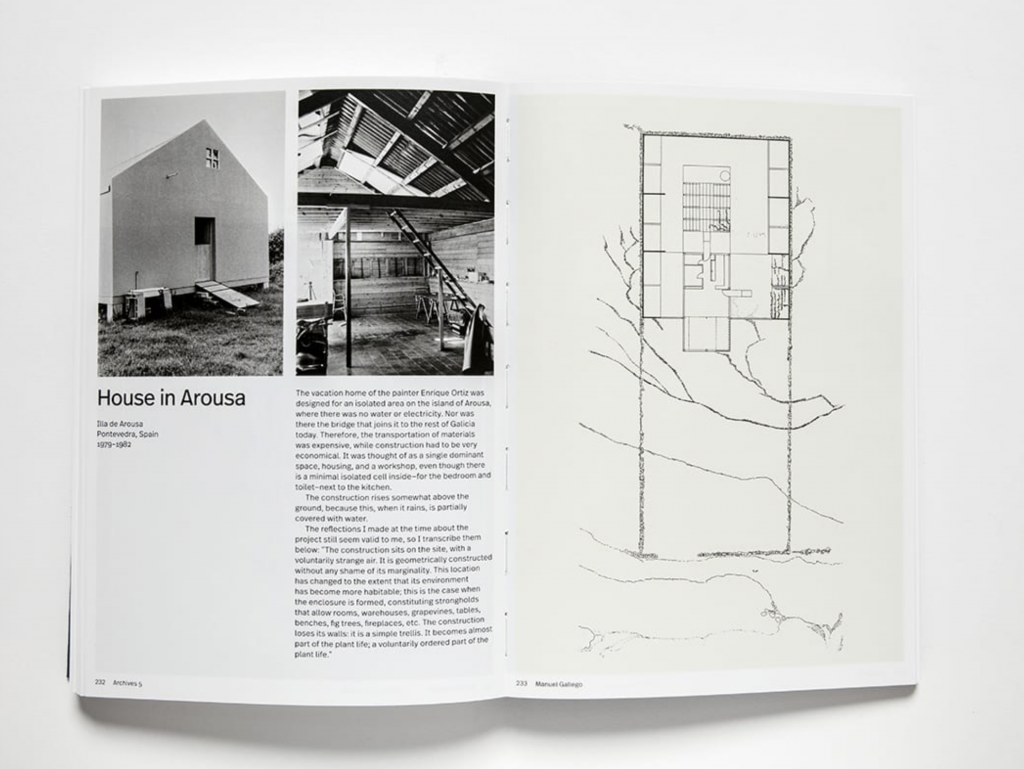
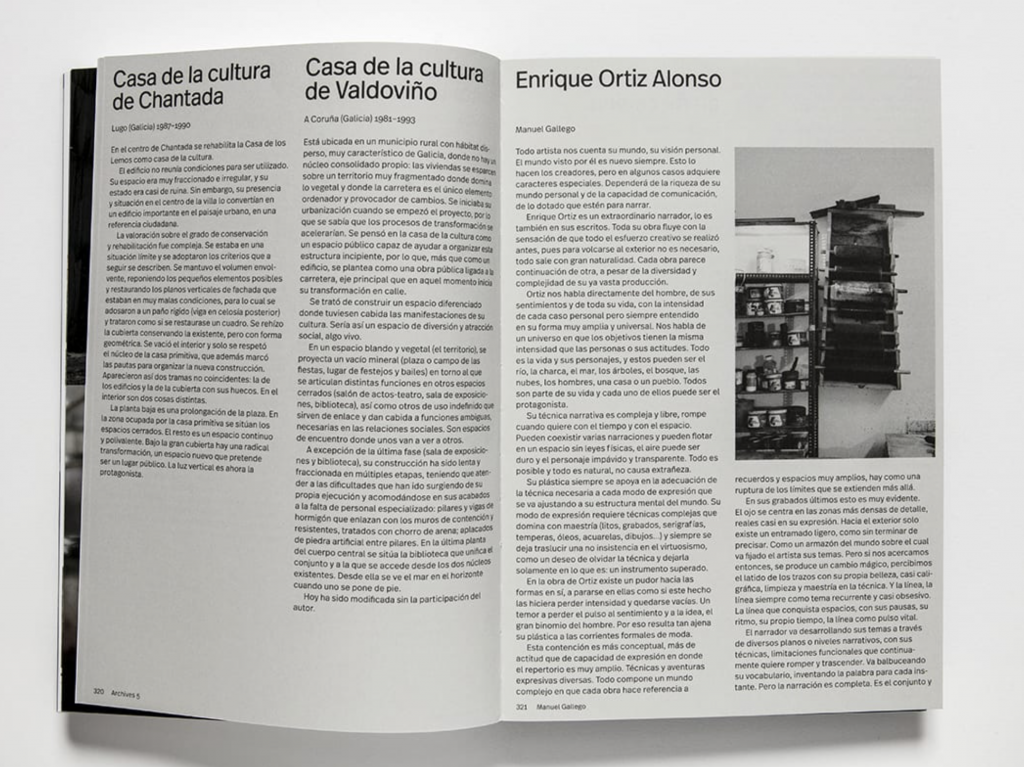
To sum up, we would not wish to limit ourselves to pointing out that this monograph is an outstanding book on the work of Manuel Gallego. It shows us with detail and criteria a work that is essential to know, a work composed by buildings as necessary as the Cultural House of Valdoviño, the fish market of Lira or the Pilgrimage Museum of Santiago. But there is something more, and much more important. We believe that we see in this Archives monograph a discourse that, by explaining Manuel Gallego’s work, has the capacity to transmit certain values about the discipline and, thus, the valuable possibility of offering tools that help to train architects for the future.
A modo de conclusión, no querríamos limitarnos a señalar que esta monografía es un sobresaliente libro sobre la obra de Manuel Gallego. Se nos muestra con detalle y criterio una obra que es fundamental conocer, obra compuesta por edificios tan necesarios como la Casa Cultural de Valdoviño, la lonja de Lira o el Museo de las Peregrinaciones de Santiago. Pero hay algo más, y más importante. Creemos ver en esta monografía de Archives un discurso que, explicando la obra de Manuel Gallego, tiene la capacidad de transmitir unos valores determinados sobre la disciplina y, así, la valiosa posibilidad de ofrecer herramientas que ayuden a formar arquitectos para el futuro.
Architecture is a weapon with a future.
La arquitectura es un arma cargada de futuro.
***
Carlos Quintáns
As an epilogue, we feel it is necessary to make some notes on the context of the publication of Archives in order to better understand the interest it arouses in us as publishers.
A modo de epilogo, nos parece necesario trazar unas notas sobre el contexto de la publicación de Archives que permitan comprender mejor el interés que como editores nos despierta.
Carlos Quintáns, architect, teacher and editor, is the director of Archives magazine together with the photographer Juan Rodríguez. His career is very close and familiar to anyone who has been more or less involved in the evolution of the context of Spanish architecture in recent years. At the head of the magazine Tectónica, he developed for more than 40 issues and a decade a committed editorial line with what he understood architecture or the position of the architect as a professional should be. In this sense, he was committed to the publication of contemporary works, placing special emphasis on their constructive and material definition. From a critical but at the same time pragmatic position, he tried to defend that the function of the architect should trace a long path from the world of ideas and the conception of spaces to the ultimate material definition of each one of the details that constitute a work of architecture. This position of the architect as a craftsman, closely linked to the construction industry, also marked a strong social commitment to his environment. Architecture had to be understood as a cultural and technical manifestation that was very much defined by the context in which it was developed, be it economic, physical or social. The architect, as a professional, had to act responsibly in each of the phases of project development in order to be able to give the most appropriate response possible according to the context in which he found himself.
Carlos Quintáns, arquitecto, docente y editor, es el director de la revista Archives junto al fotógrafo Juan Rodríguez. Su trayectoria resulta muy cercana y familiar a cualquiera que haya estado más o menos involucrado en el devenir del contexto de la arquitectura española en los últimos años. Al frente de la revista Tectónica, desarrolló durante más de 40 números y una década una comprometida línea editorial con aquello que él entendía que debía ser la arquitectura o la posición del arquitecto como profesional. En este sentido, apostó por la publicación de obras contemporáneas poniendo un especial énfasis en su definición constructiva y matérica. Desde un posicionamiento crítico, pero a la vez pragmático, trató de defender que la función del arquitecto debía trazar un largo recorrido desde el mundo de las ideas y la concepción de los espacios hasta la definición material última de cada uno de los detalles que constituyen una obra de arquitectura. Esta posición del arquitecto como artesano, muy vinculada a la industria de la construcción, marcaba además un fuerte compromiso social con su entorno. La arquitectura debía ser entendida como una manifestación cultural y técnica muy definida por el contexto en que se desarrollase, ya fuera éste económico, físico o social. El arquitecto, como profesional, debía obrar con responsabilidad en cada una de las fases del desarrollo de los proyectos para ser capaz de dar la respuesta más acertada posible en función del contexto en que se encontrase.
For all of us who trained as architects at the time when Tectónica magazine was being published, Carlos Quintáns’ editorial position was essential in helping to define our interests and our way of looking at architecture. The knowledge of the history of architecture, especially of vernacular and popular constructions, interpreted from a technical and social understanding and not so much from a historiographical or compositional one, is perhaps the contribution that we would like to point out the most.
Para todos aquellos que nos formamos como arquitectos en la época en que la revista Tectónica se editaba, el posicionamiento editorial de Carlos Quintáns fue esencial para ayudar a definir nuestros intereses y nuestra manera de mirar a la arquitectura. El conocimiento de la historia de la arquitectura, especialmente de las construcciones vernáculas y populares, interpretado desde un entendimiento técnico y social y no tanto desde uno historiográfico o compositivo, es quizá la contribución que nosotros quisiéramos señalar.
Archives: Journal of Architecture
The end of the construction bubble in Spain brought about by the last financial crisis devastated the field of architecture. Whether for this or other reasons, Tectónica abandoned its paper format and ceased publishing new issues.
El estallido de la burbuja de la construcción en España que produjo la última crisis financiera asoló el campo de la arquitectura. Ya fuera por ésta u otras razones, Tectónica abandonó su formato en papel y cesó la publicación de nuevos números.
Years after that hiatus, Carlos Quintáns returned to the role of editor with the publication of Archives: Journal of Architecture. The first issue focused on the work of architects Eva Prats and Ricardo Flores, based in the city of Barcelona.
Años después de aquel parón, Carlos Quintáns regresó a la labor de editor con la publicación Archives: Journal of Architecture. El primer número se centró en el trabajo de los arquitectos Eva Prats y Ricardo Flores, ubicados en la ciudad de Barcelona.
From the publication of the first issue we were able to draw two basic conclusions about what would become the publication of Archives. The first of these, perhaps the most obvious at first glance, is that the new publication would abandon the conventional magazine format followed by Tectónica, in which the idea of current affairs was more or less present, although it would orbit around thematic blocks defined by the materiality of the works. No longer will a collection of recent works by different authors with some common feature be published; the new Archives will be an exclusive monograph presenting different works by the same architectural practice, regardless of whether they are recent or not.
De la publicación del primer número pudimos extraer ya dos conclusiones básicas de lo que llegaría a ser la publicación de Archives. La primera de ellas, quizá la más evidente a simple vista, es que la nueva publicación abandonaría el formato de revista convencional que siguió Tectónica, en que la idea de actualidad estaba más o menos presente, aunque ésta orbitase en torno a unos bloques temáticos definidos por la materialidad de las obras. Ya no se publicarán una colección de obras recientes de distintos autores con algún rasgo en común; la nueva publicación de Archives será una monografía exclusiva que presente diferentes obras de un mismo estudio de arquitectura, independientemente de que éstas sean recientes o no.
The second characteristic of Archives that we would like to highlight is, once again, the committed editorial criteria in relation to the offices presented. We perceive in the issues published to date a common view, albeit materialised in very different ways depending on the context, of the architectural discipline and its praxis. Thus, we get the feeling that some of the postulates that built the magazine Tectónica are being taken up again to highlight once again an understanding of architecture based on the working process, the attention and response to the context and the constructive and material definition. The monographs of Archives have the capacity to construct a determined look at the world of architecture, a look with which we feel particularly identified.
La segunda característica de Archives que nos gustaría señalar es, de nuevo, el comprometido criterio editorial en relación a las oficinas que se presentan. Percibimos en los números publicados hasta la fecha una mirada común, aunque materializada de forma muy distinta en función del contexto, sobre la disciplina arquitectónica y su praxis. Así, nos da la sensación de que se retoman algunos de los postulados que construyeron la revista Tectónica para poner en valor una vez más un entendimiento de la arquitectura a partir del proceso de trabajo, la atención y respuesta al contexto y la definición constructiva y material. Las monografías de Archives tienen la capacidad de construir una mirada determinada sobre el mundo de la arquitectura, una mirada con la que particularmente nosotros nos sentimos muy identificados
The different monographic issues of Archives that have been published present a sensitivity when it comes to depicting the works that is absolutely exceptional. In this sense, the photographic work of one of the editors, Juan Rodríguez, stands out for his search for a view of architecture as a place where human activities take place. The plastic valuation of the works of architecture as sculptures, emptied of life, is relegated to the background, something that we particularly welcome.
Los diferentes números monográficos de Archives que se han publicado presentan una sensibilidad a la hora de exponer las obras que resulta absolutamente excepcional. En ese sentido, el trabajo de fotografía de uno de los directores, Juan Rodríguez, sobresale por la búsqueda de una mirada sobre la arquitectura como lugar en que se desarrollan las actividades humanas. La valoración plástica de las obras de arquitectura como esculturas, vaciadas de vida, queda relegada a un segundo plano, algo que nosotros celebramos especialmente.
Finally, we would also like to point out an inclination that we find very unusual in architectural periodicals. In Archives there is a special vocation to make each issue a personalised means of expression for each of the studies presented. There is, obviously, a structure of contents and an editorial line that are repeated and give meaning and coherence to the publication. But this structure does not, in our opinion, exhaust the possibility for each office to develop to a certain extent a more or less personalised narrative in the presentation of its work. This flexibility based on a well-defined structure greatly enriches the discourse and the approach to a particular way of understanding architectural practice.
Por último, nos gustaría señalar también una inclinación que nos resulta muy poco habitual en las publicaciones periódicas de arquitectura. En Archives se percibe una vocación especial por hacer de cada número un medio de expresión personalizado para cada uno de los estudios que se presentan. Existe, obviamente, una estructura de contenidos y una línea editorial que se repiten y dan sentido y coherencia a la publicación. Pero esta estructura no agota, según nuestra opinión, la posibilidad de que cada oficina pueda desarrollar en cierta medida una narrativa más o menos personalizada en la presentación de su trabajo. Esta flexibilidad a partir de una estructura bien definida enriquece notablemente el discurso y la aproximación a una determinada manera de entender la práctica arquitectónica.
In short, we cannot and will not hide our enthusiasm for the establishment over the last few years of Archives as one of the leading architectural monographs. The decision to offer its content simultaneously in English and Spanish guarantees it the dissemination and reach that it undoubtedly deserves, thus having the possibility of becoming a world reference. The view it offers us of our discipline, particularly charged with sensitivity, social responsibility and ecological ethics, make this hypothesis highly desirable. The ability to justifiably show the value of a well-balanced practice between the divergent lines of the local and the global, understanding these terms in the way that Bruno Latour has developed in his recent works, defines the need for this publication.
En definitiva, no podemos ni queremos ocultar nuestro entusiasmo frente al establecimiento a lo largo de los últimos anos de Archives como una de las principales monografías de arquitectura. La decision de ofrecer su contenido simultáneamente en ingles y castellano le garantiza la difusión y alcance que sin duda merece, ofreciéndole así la posibilidad de convertirse en una referencia mundial. La mirada que nos ofrece sobre nuestra disciplina, particularmente cargada de sensibilidad, responsabilidad social y ética ecológica hacen de esta hipótesis algo muy deseable. La capacidad de mostrar justificadamente el valor de una práctica equilibrada entre las lineas divergentes de lo local y lo global, entendiendo estos términos a la manera que Bruno Latour ha desarrollado en sus últimas obras, definen la necesidad de esta publicación.
